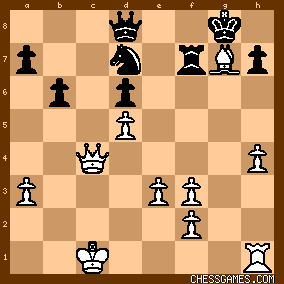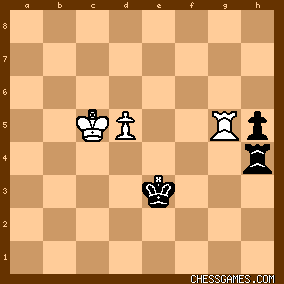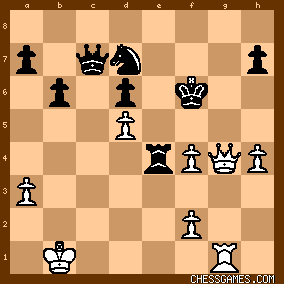| Jul-15-08 | | whiteshark: Imo, a master piece from Bareev. |
|
Nov-18-12
 | | plang: Bareev played the less popular 7 Nf3 to avoid Topalov's theoretical expertise on the more popular 7 Bg5. 11..Nd7 is the standard move; Topalov's 11..Ng5?!was new but he either overlooked or underestimated Bareev's 12 d5!. 13..dxc 14 Bxc4+..d5 15 Nxg5..Qxg5 16 Rxd5! would have been good for White. Trying to avoid the opening of the g-file with 15..Ne4 wouldn't have worked after 16 g4..Nxf2 17 Qxf2..fxg 18 Rg1!. Bareev on 23 Bxg7!:
"Of course, White has a great advantage and an extra pawn, but even so the position is not a simple win - at some point my king risks running under attack. It was for this reason that I tried to find a forcing continuation. I have no need to explain how terrifying it was to sacrifice a piece." Since there would have been no defense to the mating attack after 27..Rxe4 28 Rg1 Topalov played for perpetual check but it was not there. |
|
Oct-18-15
 | | Penguincw: Hmm. I got 23.Bxg7 Kxg7 24.Qg4+ Kf6. At that point, I would play 25.Rg1, threatening mate on g7, but there's more than one way to evade that threat. I'd give myself half credit. Tomorrow's Monday, so I should get full credit on that day. |
|
Oct-18-15
 | | An Englishman: Good Evening: Flubbed Tuesday and Wednesday, solved Saturday and Sunday. And this represents the second time this year that I "achieved" this. |
|
Oct-18-15
 | | al wazir: I got the first three moves with no trouble, and after that I would have played either the game line, 25. Rg1 or 25. e4 followed by Rg1. I think they all win. |
|
| Oct-18-15 | | stacase: Way too easy for "Insane"
I parted company at 27.Hb1 |
|
| Oct-18-15 | | diagonalley: well... even <diagonalley> managed the first four moves, so maybe my sanity is in doubt! :-) |
|
| Oct-18-15 | | agb2002: White has a bishop and a pawn for a knight.
The pawn on f3 is hanging but it's indirectly protected by Bxg7. The white pieces have open lines to attack the black king starting with 23.Bxg7: A) 23... Kxg7 24.Qg4+ Kf6 25.Rg1
A.1) 25... Qf8 26.e4 Re5 (26... Qh6+ 27.Kb1 doesn't seem to improve anything) 27.Qxd7 wins a second pawn. A.2) 25... Qh8 26.e4 as in A.1.
A.3) 25... Ke5 26.Qd4#.
B) 23... Rxf3 24.Qg4 Rf7 25.Bf6+ wins.
C) 23... Ne5 24.Bxe5 wins a second pawn. |
|
| Oct-18-15 | | agb2002: 25.Rg1 loses to 25... Qc7+, controlling g7 with tempo after 26.Kb2 Ne5. Better luck next Sunday. |
|
| Oct-18-15 | | morfishine: I got <23.Bxg7> but didn't really have time to bother with the other 20-moves ***** |
|
| Oct-18-15 | | Pedro Fernandez: Well, in my opinion solving this puzzle is simply find out 23.Bxg7! which is not so hard. But I disagree with 23...Kxg7?! due to 24.Qg4+. By moving the black king they have a better chance. |
|
| Oct-18-15 | | dfcx: White is already a pawn ahead, winning a second pawn will seal the game. I see 23.Bxg7 Kxg7 (Rxf3? 24.Qg4) 24.Qg4+ Kf3 25.e4 Re5 26.f4 Re8/Re7 (Rxe4? 27.Qg5+) 27.Rg1 with Qg4+ or Qg7 next. Is it this easy? time to check. I get the first 4 moves, but did not see the complication with Qc7+ or why black gives up its rook so quickly. |
|
| Oct-18-15 | | morfishine: <Pedro Fernandez> Interesting idea here: <...By moving the black king they have a better chance> so lets take a look. The Black King can only move to <f7> so after 23...Kf7 White still plays 24.Qg4 and wins the exchange after 24...Re5 25.Bxe5 Nxe5 26.Qf5+ unless there is some other powerful continuation, it appears Black's position if just too weak and improvements would need to be found earlier in the game |
|
| Oct-18-15 | | patzer2: In the movie "Shrek," the character of the same name says "Ogres are like onions. They have layers." However the character "Donkey" doesn't get it, as he replies "So you're like a cake. Cakes have layers." Sunday chess problems are often like onions, having many layers of difficulty. A case in point is the follow-up to today's Sunday puzzle solution <23. Bxg7!>. <Pedro Fernandez> points out the reply <23...Kxg7?!>, which allowed <24. Qg4+ Kf6 25. e4>  (+3.72 @ 22 depth), is a dubious move which improves White's winning chances. Not only does <23...Kxg7?!> improve White's chances. It also makes the win less difficult. (+3.72 @ 22 depth), is a dubious move which improves White's winning chances. Not only does <23...Kxg7?!> improve White's chances. It also makes the win less difficult. Following <23. Bxg7!> the computer gives the best move move reply <23...Rf7> (diagram below) 
click for larger view where finding a win for White gets much more difficult than the game continuation <23...Kxg7?!>. After <23...Rf7> (diagram above), playing it out move-by-move to over 25 depth with Deep Fritz 14 gives the difficult continuation 23... Rf7 24. Bh6 Qf6 25. Rg1+ Kh8 26. Qd4 Qxd4 27. exd4 Rxf3 28. Bg7+ Kg8 29. Be5+ Kf8 30. Bxd6+ Kf7 31. Re1 Nf6 32. Re7+ Kg6 33. Bg3 Nxd5 34. Rxa7 h5 35. a4 Rd3 36. Be5 Kf5 37. Rh7 Kg4 38. Rd7 Nb4 39. Rd6 Ra3 40. Kb2 Rxa4 41. Rxb6 Nd3+ 42. Kb3 Ra1 43. Rg6+ Kf5 44. Rf6+ Ke4 45. f3+ Ke3 46. Rf5 Rg1 47. Kc4 Rd1 48. Bf6 Ne1 49. d5 Nxf3 50. Bg5+ Nxg5 51. Rxg5 Rd4+ 52. Kc5 Rxh4 (diagram below) 
click for larger viewwhen White wins with 53. d6  (+7.18 @ 31 depth, Deep fritz 14). (+7.18 @ 31 depth, Deep fritz 14). |
|
| Oct-18-15 | | morfishine: <patzer2> Nice, its not a Black King move but a rook retreat to avoid losing the exchange. This improves though doesn't quite salvage the game ***** |
|
| Oct-18-15 | | Jack Kerouac: Insane?
Try this.
http://www.neatorama.com/2015/10/17... |
|
| Oct-18-15 | | patzer2: For an early Black improvement I like the Fritz suggestion 11...Nbd7 =, which completes development and avoids trading off pieces early in the opening. Matter of fact the 11...Nd7 position was reached by transposition after 9...Nbd7 10. Bb2 Ne4 11. Qc2 f5 = in W So vs Z Almasi, 2014, when a quick draw was agreed to after 12. Be2 =. |
|
| Oct-18-15 | | devere: After 23.Bxg7! Kxg7 24.Qg4+ Kf6 25.e4 Re5 26.f4 Qc7+ 27. Kb1 it's not that easy to see that after 27... Rxe4 28. Rg1 Black has no good defense:
click for larger viewBut Topalov saw it, and instead tried 27...Qc3 |
|
| Oct-18-15 | | King.Arthur.Brazil: Happily I found the sequence (maybe as saying "insane") there's not much insane things to do and of course, after 24.Qg4+,any but Kf6, lose the rook R-f5, so this is a signal of what will follow. 25.e4! (is better then my 24.Rg1, cause the N and Q are also exposed and the BR has to go to e5. But I would play 26.Rg1 before the f4. Which maybe will not give the same course of the game. The treat of Qg7+ will make the black Q stay on her board not trying checks, and maybe f4 will be more powerful too. Maybe, for this reason is not so "insane". Maybe, "unusual"... laughs... |
|
| Oct-18-15 | | whiteshark: After all this years it seems I'm getting more and more oblivious... ;( |
|
| Oct-18-15 | | Tiggler: I found all moves up to 35.Qb4 (except for the unnecessary repetition on moves 33 and 34), but only by playing it out one move at a time. Nothing insane. I assumed, however that 23.. Rf7 would have been played instead. In which case there is nothing better for white but to move the bishop away again after pocketing the g-pawn. |
|
| Oct-18-15 | | Helios727: Can't black play on for a draw after 43. Ke7 ? |
|
| Oct-19-15 | | patzer2: <Helios727: Can't black play on for a draw after 43. Ke7 ?> I think you mean 43...Ke7. If 43...Ke7, then 44. Qxb5  (+7.12 @ 23 depth, Deep Fritz 14) and White is winning easily. (+7.12 @ 23 depth, Deep Fritz 14) and White is winning easily. |
|
Oct-19-15
 | | al wazir: <agb2002: 25.Rg1 loses to 25... Qc7+, controlling g7 with tempo after 26.Kb2 Ne5.> After 25. Rg1 Qc7+ 26. Kb1 (not Kb2) Ne5 27. Qg8, threatening 28. Qe6#, I think black must play 27...Nf7. (If 27...Qf7, then 28. Qd8+ Qe7 29. Qh8+ Kf7 30. Rg7+, winning.) Thereafter it's less clear: 28. Qg7+ Kf7 29. Qxh7, and now not 29...Rxf3 because of 30. Qe4+ Ne5 31. Rg7+ Rf7 32. Rxf7+ Kxf7 33. Qh7+. Or 28. Rg7 Ke5 (not 28...Nh6 29. Qf8+ Ke5 30. Qxe5+ Nxe5 31. Rxc7 Nxh4 32. f4+ Kxd5 33. Rxh7 Nf5 36. Rxa7). |
|
Oct-19-15
 | | al wazir: Make that 30. Qxf5+, not Qxe5+. |
|





